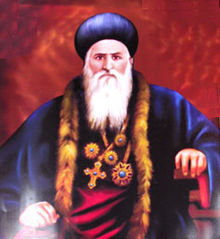Mar Ignatius Peter III, Patriarch of Antioch – Oct 8

Patriarch Mar Peter III was born at Mosul, Iraq in 1799, in a well-known Christian family of Turabdin in south east Turkey. He spent his childhood at the monastery of Hananiah (St Annanias) Monastery also known as Kurkkuma Dayro or Deir al-Zafaran Monastery. He completed his theological studies and was ordained Priest, there. Thus, his priestly formation and moulding was at this monastery. In In 1846, Patriarch Mar Ignatius Elias II ordained, Fr Pathros, as Metropolitan of Syria by name Julius (Yulios). Moran Mar Elias II passed away in 1847 and Mar Ignatius Jacob II succeeded him to the Holy Throne of Antioch and Mor Ignatius Jacob II succeeded him. Patriarch Jacob II passed away in 1871. Episcopal Synod, unanimously decided to elevate Mar Yulius as the next Patriarch. He politely refused to accept, but due continuous persuasion, he was forced, to abide by the decision of the Holy Episcopal Synod. Mar Julius Peter was enthroned in 1872.
A real God-fearing, scholar and efficient administrator who gave a structure to the Church in Malankara. At that time Malankara Church was under the tyranny of Mar Mathews Athanasius, Palakkunnath who went to Mardin earlier, with forged letters under the pretext that he was selected from Malabar to get ordained as bishop before the Patriarch H.H Ignatius Elias II. Patriarch ordained him as bishop Athanasius and sent him back to take charge of the Diocese of Malabar in 1843.
On arriving in Malankara, Patriarch Ignatius Peter III convened the Synod at St. Mary’s Church, Mulanthuruthy in 1876 and organized the Church with regard to its discipline, procedural matters etc. He streamlined the rules regarding the celebrations and worships of Passion-week starting from Hosana-Sunday to Resurrection – the Feasts of the Church. Mar Ignatius Peter III advised against conducting open procession (Raasa) through roads with drums, fireworks etc. and kiss or fondle forehead with the ornamental cross / ‘arulika’ calling it idol, forbid eating inside Churches, forbid prostrating & lighting candles before the graves/tombs of the buried bishops. Instead, to pray inside Church giving more importance to God than them, as well as the non-Christians praying and pay offerings before such graves/tombs of holy bishops by calling it ‘false-faith’ (kapada bhakthi in Malayalam), removing the graves of bishops from the alter of Churches etc. etc.
Patriarch Moran Ignatius Peter III consecrated ‘Holy Mooron’ (the Holy Oil) in the Church at Mulanthuruty. The Patriarch divided Malankara into seven dioceses – Kollam, Thumbamon, Niranam, Kottayam, Kochi, Kandanad and Angamali and consecrated Bishops to each of it, under Mar Dionysius V, the Malankara Metropolitan Pulikkottil Thirumeni.
Parumala Thirumeni Mar Gregorios Geevarghese was ordained as bishop for Niranam Diocese – All the candidates for bishop’s position were selected by Patriarch Ignatius Peter III himself, for seeing the candidate’s suitability through his spiritual eyes, as said by the Patriarch boldly; when complained by the subjects in Malankara, later on (in future) directed the Association to select candidates for the bishop position. This was a step taken by Mar Patriarch Ignatius Peter III, in part for streamlining an efficient Church administration in Malankara.
After two years of Stay in India for defending the sanctity of faith and for establishing a democratic pattern of administration of the Malankara Archdiocese, the Holy father embarked from Bombay for Jerusalem in May 1877. On his way back H.H. visited the Syrian Churches in Egypt. He reached Constantinople where he established a new church in the name of the Mother of God. Later the Patriarch left for Mar Hananyo Dayro, where he consecrated Holy Myron again. The holy father spent the remaining years in this monastery. On October 8, 1894, Mar Ignatius Pathros III passed away, at the age of 96. The mortal remains of the holy Patriarch were interred at the Mar Hananyo

0 Comments